
|
| space |
|
Sky
Crane Saves Escarpment.
|
| By
Peter Andrews, © 2002. |
| November
9, 2002. |
|
| |
|
It
was around three o'clock Friday afternoon when a familiar and
chilling, brown cloud started to appear above the campus of Wollongong's
university. Such clouds have for some time now, become the subject
of fear for many coastal, rural and mountain dwelling Australians',
living within or near the bush.
The summit of Mount Keira from
the Wollongong Botanical Gardens.
|
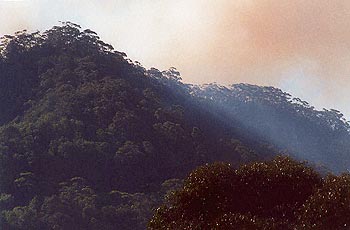
|
|
| space |
|
| It
has only being less than twelve months since those other enormous
plumes of smoke and ash, funneled their way across the Tasman
Sea to Auckland. And within their wake, burnt gum leaves were
deposited in their billions over land and sea. The high-tide mark
on many Sydney and Illawarra beaches ran black for a month or
so thereafter. So huge
were these plumes of smoke, they clearly showed up on weather
satellite photographs. And on reaching Auckland, the city's air
pollution readings went completely off the scale. |
|
| Space |
|
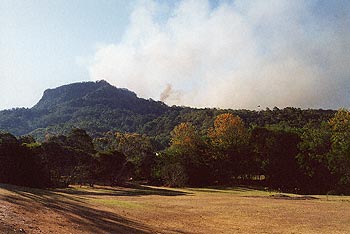
|
The full perspective
with Mount Keira and the the dying brown lawn of the Botanical
Gardens. The lawn reveals that even the coastal regions of southeastern
Australia have been in drought for quite some time.
|
|
| |
|
|
With such memories
still fresh within minds of many in southeast Australia, this
latest and quickly growing brown cloud was clearly a sign of
impending disaster.
It was reported
in the Illawarra Mercury that temperature just before three
o'clock hit 38 degrees C (100 F) at the university weather station.
And walking through a deserted botanical garden nearby around
that time, there was no difficulty in guessing that the humidity
reading was most likely to be next to nothing.
|
|
| space |
|
Fortunately for
the escarpment, the only factor missing to complete the right
mix for a total disaster was the predicted hot north-westerly
winds. But the Illawarra Escarpment in 2002 had one other benefit
that it had lacked back in 1969 on Black Friday.
The Erickson Sky Crane on its way to having a
big dump.
|
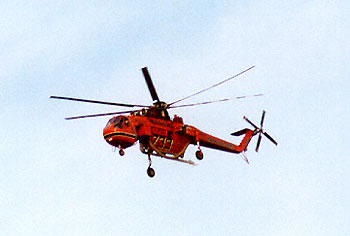
|
|
|
space
|
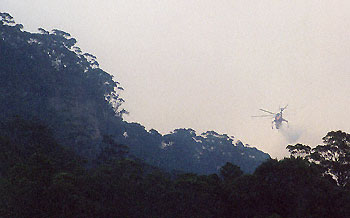
|
Due to their overwhelming
success last Summer, the popular Erickson Sky Cranes were back
to help out in what is clearly going to be another potentially
difficult season for bushfires and for those who have to fight
them.
And in action.
|
|
|
space
|
|
|
Being well into
the afternoon when this new fire had taken hold, time was limited
for any helicopter water bombing, as such a task at night is
not a consideration for safety reasons.
So with the fire
growing and time to contain it quickly running out, the huge
Erickson Sky Crane was left with little choice when it came
to a source of water.
The combination
of incorporating a quicker option of scooping up sea water just
off North Wollongong Beach and a lack of a hot north-westerly
wind, obviously paid dividends.
|
|
| space |
By lunch
the following day, most of the numerous spot fires that looked quite
threatening throughout the night, were well and truly out. The Sky Crane and other helicopters
were back out in force from dawn, this time drawing fresh water
for bombing from reservoirs at the back of the escarpment.
Scooping up sea water, just off North Wollongong
Beach. The smoke in the background is from other fires, up in the
northern suburbs of Wollongong.
|
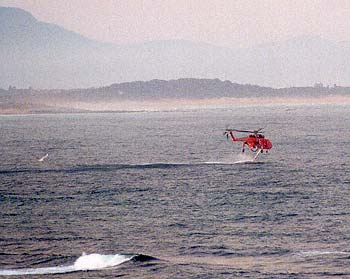
|
|
|
Space
|
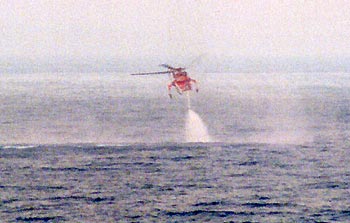
|
Many in the Illawarra
would of no doubt, be quite happy with the outcome of this bushfire,
one of a few within the region happening on the same day. However,
with predictions of very little rain until Autumn next year -- and
an enormous accumulation of mulch on the ground as a result of months
of drought conditions, there is still quite a long way to go before
any threat of any potentially dangerous fires will abate. |
|
| |
| |
|
space
|
|
|
|
A Long
Walk on a Short Day: June 22, 2001.
|
|
To the Illawarra Escarpment
Contents Page
|
|
|
|
|
Peter Andrews © 2002.
All Rights Reserved.
|

